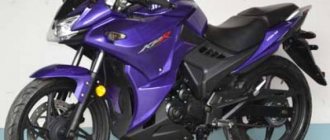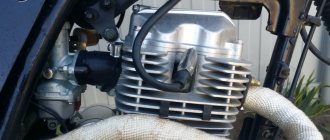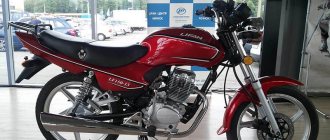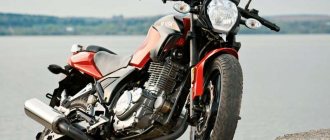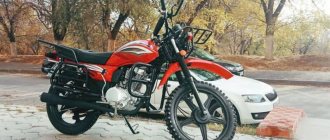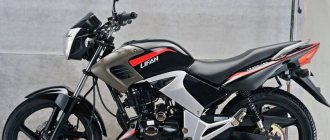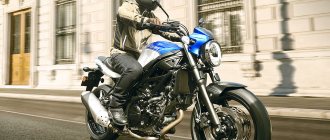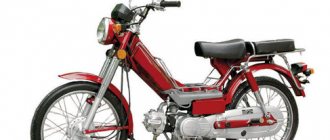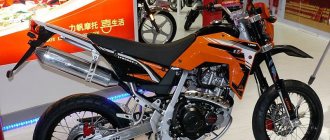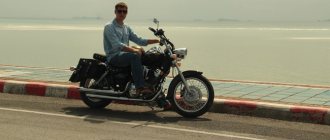Technical characteristics of Lifan LF200 GY 5
Being a full-fledged lightweight enduro, the Lifan LF 200, however, cannot boast of any impressive features. But it is truly universal - the bike feels great both in the city and on dirt tracks , and it is quite capable of off-roading You can repair and maintain it yourself, without contacting motorcycle services, since the design of the Lifan LF200 GY 5 motorcycle is extremely simple. An ordinary tubular steel frame, 1 97 cc air-cooled engine, 5-speed transmission , carburetor - everything is very simple and familiar, isn't it?
The 16.3-horsepower engine is capable of accelerating the motorcycle to 110 km/h . The declared maximum speed of the Lifan LF 200 GY 5 is quite capable, however, the acceleration dynamics are maintained only up to 70-80 km/h , after which the bike begins to noticeably slow down. If you take a passenger on board, then you can immediately forget about more or less effective acceleration. However, this applies to all small-capacity motorcycles. But off-road, the Lifal LF 200 feels quite confident - simple but reliable suspensions confidently absorb bumps, and the bike weighs only 130 kg , so it’s not difficult to handle it.
The brake system of the Lifan LF 200 also deserves a positive review - the Chinese did not skimp on disc brakes for both wheels, refusing to install a budget “drum”. This is not to say that the brakes work perfectly - let's just say they are acceptable, nothing more. But if you load the motorcycle, for example, by seating a passenger, the braking distance immediately almost doubles. In addition, sitting together will be a bit cramped, especially on a more or less long trip, since due to the shape of the seat, the passenger constantly slides forward, resting against the driver’s back. Lifan LF200 GY 5 is a motorcycle for singles , no matter how you look at it.
Model range of motorcycles
Lifan motorcycles are represented by a diverse range of models; bikes of the following series are already being produced:
Classic . Universal bikes with a straight fit and a round headlight. This series includes, for example, the Lifan LF150-13 model, with a power of 11.7 horsepower, accelerating to 100 km/h.
Chopper - models with an extended frame and front fork, high handlebars, and a large V-shaped engine. These include the Lifan LF250 model, which is an exact copy of the Japanese Yamaha Virago.
A cruiser is a motorcycle with a low seat and lower handlebars than a chopper, large fenders, additional headlights, and a powerful engine. Not suitable for fast driving. Examples of cruisers are models Lifan LF125, Lifan LF 400.
Sportbike . Motorcycles with sports suspension are designed for paved roads. This series of bikes includes, for example, the ZiD-Lifan LF 250-19R.
Dakota is a joint Russian-Chinese project of the Lifan corporation and the famous Russian Plant named after. Degtyareva (ZiD), mountains. Kovrov.
Enduro . Motorcycles for riding not only on asphalt roads, but also in off-road conditions. They are light in weight, have good impact resistance, and are easy to operate.
The enduro models include the ZiD-Lifan LF 250 gy-5 - also a joint Russian-Chinese project between Lifan and ZiD, and the Lifan LF 200 model. We will look at the technical characteristics of the latter in more detail.
Pros and cons of Lifan LF200 GY 5
Advantages
- Reliability of all main components. The motorcycle has been produced for a long time, and in the reviews of Lifan LF200 owners it is almost impossible to find anything negative about the operation of the engine, transmission or other vital elements.
- Versatility of application. Lifan LF200GY5 is perfect for the role of a utilitarian bike for all occasions.
- Power reserve . With a tank volume of 10.5 liters, the motorcycle’s gasoline consumption does not exceed 2.5 liters per 100 km (on the highway; off-road the figures will, of course, be completely different).
- Light weight . Even an inexperienced beginner can handle this bike.
- Low cost of both the motorcycle itself and its repair and maintenance.
Flaws
- Low quality of some components. Mirrors, standard circuit, fuses, light bulbs and other little things - all this can be safely changed immediately after purchase.
- Uncomfortable seat . The driver's seat quickly becomes numb, and the passenger, if there is one, slowly but surely slides off, forcing the driver onto the gas tank.
- Fragile plastic . For an enduro motorcycle, this is a rather serious disadvantage, since few people manage to completely avoid falling off-road.
The Lifan LF200 GY-5 motorcycle was purchased by me in November 2013 and has currently covered more than four thousand kilometers. Overall I really like the motorcycle. I can easily go on any trips through forests and fields with it. After the purchase, I deliberately did not climb anywhere on the motorcycle, did not twist or tighten anything, just to look at the reliability of the equipment. At the moment I can say: the device is worth the money, it lives up to expectations and does not let me down. If anyone is interested in a description of this miracle of Chinese technology, please click here
What was replaced in the motorcycle during this time: *chain *rear brake pads *rear turn signal *oil twice *lamp in the headlight *tail lamp *clutch lever *mirror mount *both mirrors *brake fluid in the rear brake *evil tires ", for soil
It seems like I haven’t forgotten anything else.
The chain, as everyone says, is completely plastic, it stretches very willingly, it was possible to tighten it every two hundred kilometers, but I did it less often, only five times in 3000 kilometers. And for the first five hundred I actually didn’t lubricate it, even though I drove it in winter. I just watered it with a spray can of lubricant until it was lightly damp on one side. The motorcycle was used both on asphalt and on dirt. While overcoming slides, mud, digging into deep sand and quite fast (as far as my experience allowed) grips in the company of experienced comrades, the chain experienced significant loads; if you drive more carefully, it will last much longer. It was replaced because it was no longer possible to tighten it; the length of the adjustment hole in the pendulum was completely selected. By the way, I recommend immediately replacing those plates into which the tension nut rests - they are very easily crushed with a wrench. Replaced it with a chain recommended by many from the Ant scooter. 128 links are enough to fit evenly on the sprockets in the closest position of the wheel. After the first hundred kilometers it stretched and was adjusted normally. It doesn’t stretch much further by native Chinese standards. And it rustles differently, quieter.
Rear pads...
They wore out so quickly for four reasons: a) I drove a lot in mud, and there was no protection against dirt. b) I often use the rear brake when maneuvering at low speeds, this stabilizes the motorcycle c) while I was wearing universal tires, I attended gymkhana training d) there is too much brake fluid in the rear brake system, as they say, it was because of this that the pads were not completely retracted from the disc and overheated. This is “treated” by releasing some of the fluid through the bleeder fitting while pressing the brake pedal.
The rear turn signal was broken in a fairly hard fall while climbing a hill. I couldn’t find the turn signal glass separately for sale, so I had to buy it assembled.
The standard mirrors are not very good or comfortable. They have a short shaft and when moving you can only see either your own elbows or the side of the road. I had to tuck my elbows in to see the situation behind me.
The first mirror was broken at the same time as the rear turn signal; in that fall, I flew over the steering wheel and damaged the plastic of the mirror. I broke the second one by hitting a tree during another fall; the direction of the impact was so inconvenient that not only the mirror broke, but also the part on the steering wheel handle into which the mirror is screwed. Replacing this mount required removing the left console, handle and headlight to get to the block that prevents the engine from starting in gear without the clutch being depressed.
Both bulbs burned out after some pretty hard driving along forest roads. Replacement is not a problem. The headlight is secured with three large screws, the rear light with two small ones.
When removing the front wheel, pay attention to the position of the speedometer mechanism.
Removing the rear wheel is not a problem; for convenience, you can remove the brake caliper. Reinstallation is complicated by the need to first insert the caliper mounting bracket behind the pendulum. It also serves as a spacer insert.
Rear brake pads are very easy to change: remove the caliper by unscrewing two bolts, turn it over, unscrew the two internal hexagons, the pads will fall out. They are different, one with a bracket, do not confuse them. Before installing the pads through the spacer (you can use old pads), slowly press the pistons into the caliper.
It is worth disassembling the caliper and lubricating the guides with a special grease for caliper guides, sold in car dealerships.
On standard, “universal” tires, the motorcycle rides quite normally; you only feel its plasticity during the first couple of hundred kilometers. I even rode it in November 2013, immediately after buying the motorcycle. Of course, you can’t enter a turn on your knees, but it’s quite possible to drive. These tires don’t give up on dirt roads either: I rode them in mud, and on sand, and on gravel, and on snow, and took on solid hills, and rode along roads. Yes, slowly, but with pleasure and without problems.
* *
By the way, if you inflate the tires not to the standard 1.7-2.0, but deflate them to 1.4-1.7, the motorcycle rides noticeably more confidently. I went to Gymkhana, did exercises, and slowed down. The tires are not great, but good, I was able to corner the bike quite well, and the braking is quite good: from 60 km/h the braking distance is 14 meters, as expected. By the way, motorcycle gymkhana classes are very useful; you feel more confident on the road.
The fuel consumption of my motorcycle in the first thousand during the break-in period was 2.7, in the second, when I started riding on dirt and allowed you to unscrew the throttle more, the consumption increased to 3.3. I measured the mileage of a thousand kilometers, filling up at one pump under a traffic jam.
With the installation of “evil” Dunlop Geomax MX51 dirt tires, consumption even on asphalt increased to 3.5 liters per hundred kilometers. But this takes into account long-term driving in low gears in heavy soils and on obstacles, as well as training on the enduro track.
*
The evil tires hold up very well, I ride quite confidently in a group of motorcycles on the slips, unless, of course, they are too fierce on the straights.
Taking on slides on these wheels is a pleasure and you can brake much more efficiently. But this comes at the price of mediocre stability on asphalt. It holds, of course, but you won’t be able to accelerate. And even on asphalt you need to brake more actively using the rear brake. The wear and tear on the asphalt is very noticeable, so now I try not to go to special roads again.
*
The seating position for tall riders will not seem very comfortable; the footpegs are still a bit high. But this is felt only on asphalt; on the ground you have to ride in a stance. The seat is normal, you can drive a hundred, even a hundred and fifty kilometers on asphalt (I did), then you need to warm up, a “fence” is a “fence”. Riding while standing is a pleasure! Despite the rather weak-looking front fork, the motorcycle absorbs bumps easily and smoothly. Motorcycle boots fit neatly between the tank and the seat, allowing you to fix the motorcycle without squeezing it too much, giving it the opportunity to handle the profile of the road, or rather, the direction that you call the road. Even like this ( NOT me in the picture!):
But it’s better not to carry a passenger off-road.
I would especially highlight this unpleasant feature: water from any puddle flies from under the front wheel directly onto the motorcycle boots. The rear one, on the contrary, does not stain the rider when slipping in mud or water, the wing saves. In the city, the dynamics of the motorcycle are quite enough, but on the highway you have to hug the side of the road, letting flyers pass; one hundred kilometers per hour (according to GPS) is not enough on the highway. The speedometer shows one hundred and twenty at this time. Despite the fact that up to eighty kilometers per hour, the speedometer readings almost coincide with the GPS.
Gears shift easily and clearly. There are no complaints about the operation of the box. It is better to engage neutral from second gear. The engine itself surprises with tractor traction at the bottom; the motorcycle can crawl up a hill at the speed of a sick turtle! On a flat road you can start even in third gear. At the same time, the clutch slips jerkily. Engine braking is quite effective; when you shift down a gear, it becomes stronger. I highly recommend practicing combined engine braking and standard brakes - it significantly reduces braking.
With some skill, it is possible to change gears up and down without using the clutch, according to engine speed. But it’s better not to abuse this.
Overheating does not particularly affect the behavior of the engine; gears shift harder and it is more difficult to catch neutral.
The engine first ran on 95 gasoline, then I filled it with 92, I didn’t notice any significant changes in the behavior of the engine, except that it began to run a little softer. It starts in any weather, even at minus twenty. Either with an electric starter or with a kick starter. Feature: when starting with a kick starter, the throttle should be opened almost to full throttle. With an electric starter, on the contrary, do not touch the handle when starting, but gradually add gas at the very beginning of operation and release.
There is ice on the dashboard! (this is a screenshot from the video)
An unpleasant feature: the gas tank cap does not have a sealing gasket and gasoline leaks through it during active maneuvers and falls. When dropped, gasoline also leaks through the carburetor.
The sound from the exhaust pipe was quite quiet at first, then became louder. Now at idle it remains quiet, but at idle it sounds loud and even pleasant.
The plastic, it turns out, is not colored in bulk, but only on the surface; the motorcycle boots tore it off the decorative trim without damaging the plastic itself.
The width of the steering wheel is sufficient, but in traffic jams between the rows you want to shorten it a little. But then he won’t be enough on the ground.
The buttons on the remote control are pressed quite normally, everything is in its place, convenient. True, the side light and headlight switch sometimes falls down due to shaking and only the side light shines instead of the low beam headlight.
There is absolutely not enough headlight light! At all! When I had to return at night off-road, I lowered the headlight so that the distant light shined on the road. At least it's visible somehow. People advise installing xenon, the power supply for the standard lamp is 35 watts, it should be just right. I'm afraid that the lens and headlight housing will melt, maybe I'll just install additional LED lights.
Lifan withstood more than a dozen falls during endour rides and one on the asphalt. The broken mirrors and clutch handle do not count.
I like the motorcycle. It allows you to practice special enduring exercises, or simply drive around the city and fields, and rush off-road for your own pleasure!
Reviews from Lifan LF200 GY 5 owners
A comfortable moped, nothing superfluous, it just looks a little boring, a kind of hello from Soviet times. I bought a motorbike relatively recently, it has driven a little more than six thousand so far, the only complaints I have are the original chain, it stretches like chewing gum, I had to tighten it every 200-300 km. My patience ran out and I changed it to another one. There is no visibility into the original mirrors, I bought new ones for 1200 rubles. The original battery died quickly until I bought a new one and used kickstarter. Anatoly, Istra, Lifan LF200 GY 5 '2018.
I expected more from Lifan, I read a lot of reviews, everyone praises it, but, in my opinion, the motorcycle is overrated. The suspensions are frankly weak, the engine is sluggish, there is no acceleration, after 60-70 km/h it no longer drives, plus the vibrations are unrealistically annoying. There were no breakdowns, the bike was taken from hand, the mileage is now 19,000 something. Evgeniy, Izhevsk, Lifan LF200 GY 5 '2014.
It looks clumsy, but it rushes along so cheerfully, including off-road. I threw out the original tires almost immediately after the purchase, installed the evil Shinka, tried it on the field - the difference is huge. The Chinese are really great, the motorcycle is not at all bad, the spare parts cost a penny, there are no breakdowns yet, I like everything. Ivan, Yaroslavl, Lifan LF200 GY 5 '2017.
Briefly about the manufacturer
Lifan Corporation (translated from Chinese as “Going Full Sail”) was established in China in 1992. The central company is located in Chongqing.
Initially it was planned that it would be a company producing budget versions of cars, motorcycles, scooters, scooters, ATVs, all-terrain vehicles and other motor vehicles.
Also engines for them, for a wide variety of segments of the population.
Now the company is included in the list of 500 largest private industrial enterprises in China.
At the same time, despite the fairly high quality of its products, it continues to keep prices at a quite acceptable level.
In 2006, 14 years after its creation, the corporation had already produced:
- 1,330,000 motorcycles exported to more than 140 countries, including Russia, Germany, Canada, the United States of America;
- 2,540,000 motorcycle and scooter engines;
- the first passenger car of the Lifan 520 brand (in Russia known as Lifan Breez).
Children's motorcycle equipment for motocross will help protect a young motorcyclist from injuries.
How to choose the right Baffin shoe for snowmobiling.
Total
Having ridden the Lifan LF200 at least a little, you understand why it is so loved by motorcyclists. This bike is good because for a small price buyers get everything they need - a balanced, universal motorcycle for all occasions. Old-fashioned and at first glance rather inconspicuous, the Lifan LF 200 has other advantages - reliability, ease of maintenance and low cost of maintenance. This bike can be safely recommended to all beginners as a “study desk” .
Price
When compared with European brands or equipment from Japan, the Chinese brand Lifan has an incredibly low cost of its motorcycle equipment. Even if we compare the Lifan 200 GY-5 with other Chinese enduro brands of similar volume, the price of the motorcycle is still one of the best.
As a result, the price tag for Lifan 200 GY-5 varies from $1,100 to $1,500; if you wish, you can buy Lifan 200 for about $700. Finding spare parts is quite simple, because the brand is quite popular and has a large selection of parts.
Video Review
Specifications
| Maximum engine power: | 16.3 hp at 8000 rpm (11.98865 kW) HP |
| Working volume: | 196.9 cm3 |
| Motor type (cylinder arrangement, number of strokes): | |
| Number of valves: | |
| Intake type (Injector / Carburetor): | |
| Bore and stroke: | |
| Starting system (Electric starter, kick starter): | |
| Maximum speed in km/h: | 110 km/h |
| Cooling system: | Air cooling |
| Transmission (gearbox): | 5-speed, manual |
| Clutch (Dry / Wet): | |
| Drive unit: | Chain |
| Frame: | Steel tubular |
| Chassis | |
| Suspension (front/rear travel): | |
| Brakes (Front/Rear): | |
| Wheels / Tires / Rubber: | |
| Dimensions and weight | |
| Dimensions (Length / Width): | |
| Seat height: | |
| Ground clearance: | |
| Curb weight: | |
| Wheelbase: | 1450 mm |
| Weight: | 122 kg |
| Fuel tank capacity: | 10.5 l. |
| Battery capacity: | |
| Year of release: | |
| Country of Origin: |
